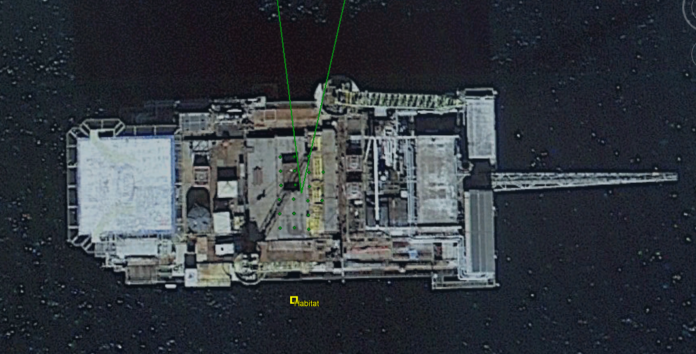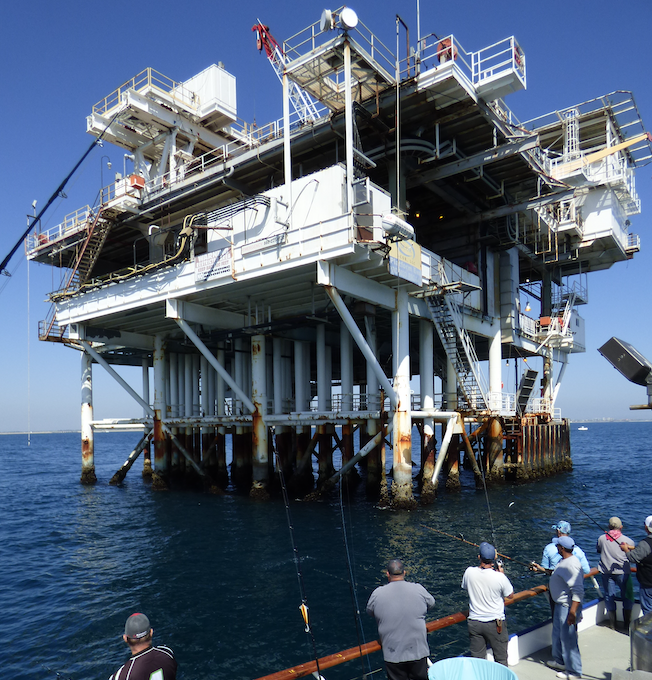
BY MERIT McCREA
When you look at an offshore oil platform up close it’s actually difficult to see it as an all-same all-around structure, no differences from side to side, top to bottom. But there is quite a bit of difference and some common structures all share.
First, some terminology, then a bit on basics, some on biota and fish and finally, fishing them effectively.
Oil platforms are the structures standing in the sea, while oil rigs are the actual drilling gantries atop them. On deck there are cranes for on and offloading of materials, trash and sometimes even personnel.
Most times people are moved daily by boat and there are several boat landings located around the platform at water level. These are mounted to the platform “jacket” and stand out from it, extending down into the water just 10 or 20 feet.
The jacket itself is the main structure of the platform, standing on the seafloor (west coast rigs). Our platforms are some of the largest free-standing ones on earth and none the size of our larger ones have ever been removed – the gear and technology to do so has not yet been developed.
When a platform reaches the end of its life as an oil and gas production facility the shut down and disposition is called decommissioning, while for the wells themselves it’s P&A – plugging and abandoning. Those are the terms you’ll see and hear being used when they talk about platform end-of-life activities.
The “topsides” of an oil platform hold the helipad, living quarters, office facilities, galley, plus the mobile drill deck and rig, those cranes, some pre-processing tankage, plumbing and a flair boom extending off and above the platform. If you’ve been out to the “double rigs” off Long Beach you may have noticed one of them is entirely production, while the other is entirely pre-processing.
Platforms are most often plumbed together via pipelines, even when they are owned by different companies. Such is the case at the double rigs and several platforms send product to them.
On a production platform there may be 30 or more different wells, and directional drilling sends these off in many different directions, even more than one branch off a single main bore.

What you’ll see going into the water from the drill deck are a number of “conductors” spaced about 5 feet apart, just enough space between the heavy marine growth on adjacent ones for us to squeeze through during surveys.
The jacket itself has multiple levels of lateral beams that tie the vertical and diagonal piers together. Usually these are spaced 20 to 40 feet apart – typically one at about 25 feet below the surface, another around 45, then one around 80 to 100 feet, and so on.
Through each of these “levels” the conductors run through guides and these conductors flex slightly with the surge – big pipes, lots of force. Within the conductors are multiple concentric pipe layers, the casing, the drill line…
On the topsides, there is often a heliport on one side, drill deck with a huge mobile table capable of moving the drill rig over any of the many conductors, either on one side or both or center. You’ll be able to see the conductor bay looking under the platform for the many vertical pipes, and spot the drill rig topsides above it. However, on many platforms just the cranes remain.
Angled out to one side is the flair-boom, and at night from a distance the platform can look like a giant Aladdin’s lamp as they flair off natural gas. Flaring can happen while drilling when pressures coming back up the well get too high.
More often it happens while they’re pigging the lines – running a cleaning device (the pig) through the pipelines between the rigs and shore. That’s why you typically see flaring from multiple platforms at once.
When platform Hondo was first drilling the flair would be hundreds of feet high, and aboard the Condor making our way to San Miguel in the dark we could feel the heat radiating from it, miles off the platform, like standing in sunshine.
As far as fish and biota, platforms form one of the most ecologically rich reef structures there are. Not only do they offer all-level reef habitat far from the silty influence of the shore, but they offer tremendous interior space.
All that reef habitat and life is uniquely packaged, from surface to deep ocean critters all at a single spot a few hundred feet in diameter, yet as much as 1,200 feet deep with above-water structure to 300 or more feet.
From the surface down to the upper thermocline – usually between 40 and 80 feet down depending on the season, you’ll encounter calico bass, huge sheephead, blue perch, tons of blacksmith, shoals of baitfish of all kinds just off the platform, schooling fish like bonito and yellowtail may come seasonally too.
In the colder waters below, there are all manner of rockfish, from shallow waters species like blues high in the jacket, to deep water species like cows and even bank and Mexican rockfish on the deeper rigs. A few are deep enough to have blackgill. More on this subject here and here.
In state waters (3 miles and less from shore) you have the right to fish right up to the platform, but not from it. Outside state waters it’s not so clear-cut, but typically if you stay out of the way of operations there’s no problem. Fishing bass on inshore rigs in less than 80 feet of water the key is to stay away from the platform and cast in.
At deeper platforms the trick is to anchor off up current, which can be tricky, then fish fly-line. It’s extremely difficult to keep an artificial capable of being cast into the strike zone above the upper level for long.
You basically have to line-drive a swim bait between the lowest overhang and the water, although I have seen a few fish pulled up and over the cross beam when anglers have cast over it instead. For private boaters, a spot-lock capable trolling motor would be key.
Because the jacket extends out at an angle, a giant pyramid, fishing rockfish can be done dropping straight down some distance from the platform at the surface. It’s a snaggy proposition if you’re too close and circle hooks are the way to go.
Most of the fish tend to hang out just along the up-current face and in the conductors. We surveyed an analyzed the difference in fish numbers between the conductors and the rest of the structure and found it to be substantial.
Unfortunately all of the decommissioning options but the legally required but equally unavailable “no action” alternative call for pulling them, and it’s likely simply an oversight.
Merit McCrea is saltwater editor for Western Outdoor News. A veteran Southern California partyboat captain, he is a marine research scientist with the Dr. Milton Love Lab at the University of California at Santa Barbara’s Marine Science Institute. He serves on the Groundfish Advisory sub-Panel of the Pacific Fisheries Management Council, the Santa Barbara Harbor Commission, The Channel Islands National Marine Sanctuary Advisory Council and the CCA-Cal State Board. He can be reached at: merit@wonews.com



